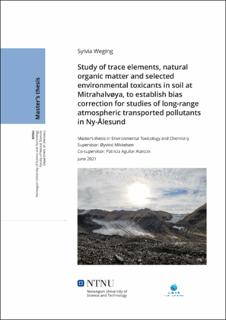| dc.description.abstract | The Arctic archipelago Svalbard is an important receptor for long-range atmospheric transported
contaminants. However, local emission sources exist as well, but have been only documented in
few studies. Accelerated solvent extraction (ASE) along with gas chromatography (GC) coupled to
single quadrupole mass spectromety (MS) has been widely used for the extraction and quantification
of PAHs and PCBs in solid environmental matrices, but with the drawbacks in previous methods
of e.g. distinct GC separation protocols for PAHs and PCBs, demanding more time and cost for
analysis. In this study, surface soil samples were collected in the vicinity of Ny-Ålesund and on two
locations remote from the settlement: Kiærstranda and Mitrahalvøya and analyzed for elements As,
Cd, Cr, Cu, Ni, P, Pb and Zn, PAH and PCB content as well as total carbon (TC), total nitrogen (TN),
biologically labile total organic carbon (TOC400), residual oxidizable carbon (ROC), total inorganic
carbon (TIC900). The aim of this study was to to develop an ASE-GC-single quadrupole-MS method
for the simultaneous extraction, cleanup, detection and quantification of PAHs and PCBs in Arctic
surface soils. With this methodology, current data on the concentration of PAHs and PCBs in
Artic soil was reported and related to the profile of inorganic contaminants measured in the Arctic
soil to (1) identify possible contamination sources of PAHs, PCBs and trace elements and to (2)
examine spatial variations of contaminant concentrations in different areas of the Arctic. Analysis
of elements revealed more than 10-fold higher concentrations of Cd in Kiærstranda (4.15-4.49 μg
g−1) than the other study areas (0.10-0.51 μg g−1). Together with significantly higher TN and P
levels at Kiærstranda, these findings suggest a transfer of Cd by seabirds from the marine food
web to terrestrial environments as a potential source. Other elements did not show statistically
significant spatial variation. Mean As, Cr, Cu and Ni levels in surface soils from this study were
higher than reported values in surface soils from Norway. Different sources may have contributed to
found levels in surface soils, such as the local bedrock. The developed method for the simultaneous
extraction, cleanup, separation and quantification of PAHs and PCBs proved to be successful with
recoveries between 80-106%, precision with RSD < 15% and limits of detection (LOD) between
0.67-6.67 ng g−1 for PAH and PCB target analytes. The developed method was applied to analysis
of sampled surface soils for 16 U.S. EPA PAHs and 7 indicator PCBs. Levels of PAHs and PCBs
were <LOD for samples from Mitrahalvøya. 10 of 16 PAH target analytes were above detection
limits in Ny-Ålesund and Kiærstranda with total PAH levels ranging from 12.4-533.6 ng g−1. An
alkylated PAH compound that has been documented to be a dominating compound in Svalbard
coal, retene, has been confirmed in soil samples from the vicinity of Ny-Ålesund. Spatial variation of
PAH concentrations was noted in samples from Ny-Ålesund area. Moreover, the presence of heavier
molecular weight PAHs, could be confirmed in the vicinity of Ny-Ålesund and on Kiærstranda,
suggesting that local sources contribute more likely than long-range atmospheric transport to PAH levels quantified in soils from these study areas. The dominance of PHE, NAP and FLU, the presence
of retene as well as PAH indicator ratios point towards a mixture of unburnt coal and combustion
of coal and fuel being likely sources for PAHs found in soils from Ny-Ålesund. 5 of 7 PCB target
analytes were >LOD in two samples on Brøggerhalvøya with total PCB levels between 37.9-45.9 ng
g−1. The proximity to the shore of the two sampling locations possibly points towards influences
from oceanic currents or transfer by seabirds from the marine food web as potential PCB sources to
these locations.
Keywords: PAHs, PCBs, trace elements, soil, Arctic, Svalbard | |
